-
 Bitcoin
Bitcoin $82,373.9697
-3.36% -
 Ethereum
Ethereum $1,851.6745
-2.19% -
 Tether USDt
Tether USDt $0.9995
-0.01% -
 XRP
XRP $2.1068
-5.67% -
 BNB
BNB $604.3688
-4.21% -
 Solana
Solana $125.7138
-4.63% -
 USDC
USDC $1.0000
0.01% -
 Dogecoin
Dogecoin $0.1713
-5.80% -
 Cardano
Cardano $0.6723
-4.55% -
 TRON
TRON $0.2343
1.95% -
 Toncoin
Toncoin $3.6885
-8.69% -
 Chainlink
Chainlink $13.7038
-4.56% -
 UNUS SED LEO
UNUS SED LEO $9.5887
-1.08% -
 Avalanche
Avalanche $20.0178
-2.55% -
 Stellar
Stellar $0.2684
-2.91% -
 Shiba Inu
Shiba Inu $0.0...01276
-4.74% -
 Sui
Sui $2.3137
-9.11% -
 Hedera
Hedera $0.1708
-7.54% -
 Litecoin
Litecoin $86.3372
-2.01% -
 Polkadot
Polkadot $4.0851
-4.64% -
 MANTRA
MANTRA $6.3082
-1.10% -
 Bitcoin Cash
Bitcoin Cash $304.0264
-2.74% -
 Bitget Token
Bitget Token $4.5892
-3.43% -
 Pi
Pi $0.8035
-3.52% -
 Dai
Dai $0.9999
-0.01% -
 Ethena USDe
Ethena USDe $0.9992
0.03% -
 Hyperliquid
Hyperliquid $12.6865
-8.10% -
 Monero
Monero $215.4800
-2.52% -
 Uniswap
Uniswap $6.0913
-2.75% -
 Aptos
Aptos $5.3753
-2.22%
what is blockchain and distributed ledger technology
Blockchain, a secure, transparent DLT, uses a shared, immutable ledger and consensus mechanisms to verify transactions across various networks (public, private, permissioned), with applications extending far beyond cryptocurrencies to supply chain management and voting systems.
Mar 24, 2025 at 08:00 pm
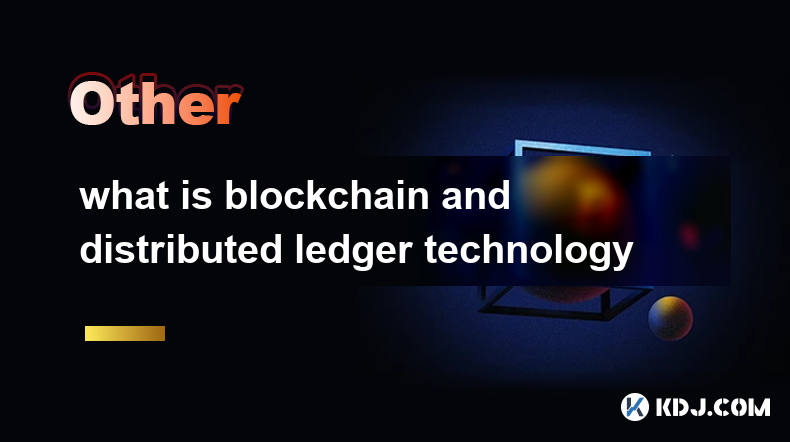
Key Points:
- Blockchain's core function: A shared, immutable ledger ensuring transparency and security.
- Distributed Ledger Technology (DLT): The underlying technology enabling blockchain's decentralized nature.
- Consensus mechanisms: How blockchain networks agree on the validity of transactions.
- Types of blockchain: Public, private, and permissioned, each with distinct applications.
- Applications beyond cryptocurrencies: Supply chain management, voting systems, and more.
- Security implications: Decentralization enhances security but introduces new challenges.
- Scalability and efficiency: Ongoing development to improve transaction speeds and costs.
What is Blockchain and Distributed Ledger Technology?
Blockchain technology is a decentralized, distributed, and public digital ledger that is used to record and verify transactions across many computers. It's essentially a continuously growing list of records, called blocks, which are linked and secured using cryptography. Each block contains a timestamp and a link to the previous block, creating a chain of data that is incredibly difficult to alter or delete. This immutability is a key feature that provides security and trust.
Distributed Ledger Technology (DLT) is the broader concept encompassing blockchain. DLT refers to any database replicated and shared across multiple participants. Blockchain is a specific type of DLT that utilizes a chain of blocks and cryptographic hashing to secure the data. While blockchain is the most well-known example of DLT, other DLT architectures exist, each with its own strengths and weaknesses. The core principle of DLT is decentralization, eliminating the need for a central authority to manage the database.
How does Blockchain Work?
A crucial aspect of blockchain is the consensus mechanism. This is the process by which the network agrees on the validity of new transactions and adds them to the blockchain. Popular consensus mechanisms include Proof-of-Work (PoW), commonly used in Bitcoin, and Proof-of-Stake (PoS), used in Ethereum 2.0. These mechanisms ensure that no single entity can control the network or manipulate the ledger.
Once a transaction is verified, it is bundled into a block along with other transactions. This block is then added to the existing blockchain, creating a permanent and verifiable record. The cryptographic hashing ensures that any changes to a block will be immediately detectable, maintaining the integrity of the entire chain. The distributed nature of the ledger means that copies of the blockchain exist across multiple computers, making it extremely resistant to censorship or single points of failure.
Types of Blockchain Networks:
- Public Blockchains: These are open to anyone, allowing anyone to participate in the network, view transactions, and create new blocks. Bitcoin and Ethereum are examples. Transparency is a key advantage, but scalability can be a challenge.
- Private Blockchains: These are permissioned networks controlled by a single entity or organization. Access and participation are restricted, offering greater privacy but sacrificing decentralization. These are often used within companies for internal applications.
- Permissioned Blockchains: These networks offer a middle ground, allowing a select group of participants to join and participate while maintaining a degree of control and privacy. This allows for a balance between transparency and access control.
Beyond Cryptocurrencies: Applications of Blockchain:
Blockchain's potential extends far beyond cryptocurrencies. Its applications are vast and rapidly evolving:
- Supply Chain Management: Tracking goods throughout the supply chain, enhancing transparency and accountability.
- Healthcare: Securely storing and managing patient medical records, improving data privacy and interoperability.
- Voting Systems: Creating a transparent and tamper-proof voting system, reducing the risk of fraud.
- Digital Identity: Providing secure and verifiable digital identities, streamlining various processes.
- Intellectual Property: Protecting intellectual property rights through secure and verifiable records.
Security and Scalability Challenges:
While blockchain offers enhanced security through decentralization, it also introduces new challenges:
- 51% Attacks: A malicious actor controlling over 50% of the network's computing power could potentially manipulate the blockchain.
- Smart Contract Vulnerabilities: Bugs in smart contracts can lead to significant financial losses.
- Scalability: Processing a large volume of transactions efficiently remains a challenge for many blockchain networks.
Common Questions and Answers:
Q: What is the difference between blockchain and a traditional database?
A: Traditional databases are centralized, controlled by a single entity. Blockchains are decentralized, distributed across multiple computers, making them more secure and resistant to manipulation.
Q: How secure is blockchain technology?
A: Blockchain's cryptographic security makes it extremely difficult to alter or delete data. However, vulnerabilities in smart contracts or 51% attacks remain potential threats.
Q: Is blockchain technology environmentally friendly?
A: Proof-of-Work blockchains, like Bitcoin, require significant energy consumption. Proof-of-Stake and other consensus mechanisms aim to reduce energy usage.
Q: What are the future prospects of blockchain technology?
A: Blockchain technology is still evolving, but its potential to revolutionize various industries is significant. Ongoing development focuses on scalability, efficiency, and user-friendliness.
Q: Can I use blockchain technology without understanding cryptography?
A: While you don't need to be a cryptographer to use blockchain applications, understanding the basic principles of cryptography is helpful for appreciating its security features.
Q: What are the limitations of blockchain technology?
A: Limitations include scalability challenges, regulatory uncertainty, and the potential for misuse. Furthermore, the energy consumption of some consensus mechanisms is a concern.
Disclaimer:info@kdj.com
The information provided is not trading advice. kdj.com does not assume any responsibility for any investments made based on the information provided in this article. Cryptocurrencies are highly volatile and it is highly recommended that you invest with caution after thorough research!
If you believe that the content used on this website infringes your copyright, please contact us immediately (info@kdj.com) and we will delete it promptly.
- In the Midst of Solana’s Meteoric Rise, a New Player Emerges
- 2025-03-29 19:50:12
- BlackRock and Grayscale Have Entered Avalanche's (AVAX) Market
- 2025-03-29 19:50:12
- Bitcoin (BTC) Price Drops Against Both US Stocks and Gold, as Gold Outperforms BTC by 17% YTD
- 2025-03-29 19:45:12
- Dogecoin (DOGE) Price Action Reaches a Point of Great Importance
- 2025-03-29 19:45:12
- Coinbase users lose over 400 Bitcoins worth $33.5 million in social media engineering attacks
- 2025-03-29 19:40:13
- Chainlink (LINK) Price Prediction: Targeting a 35% Increase as It Tests the $14 Support
- 2025-03-29 19:40:13
Related knowledge
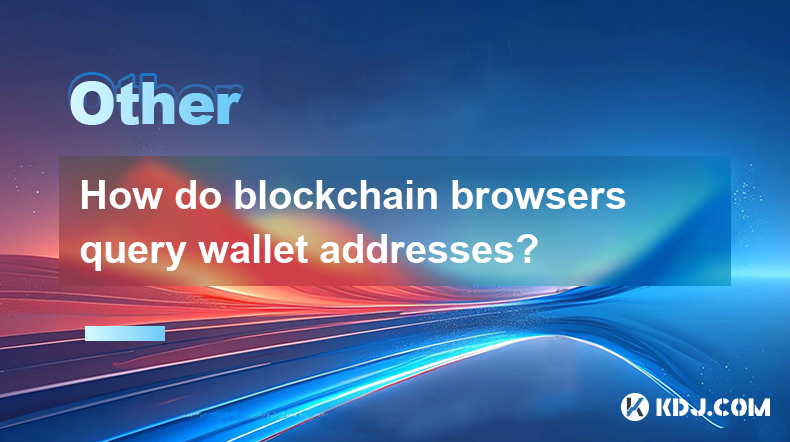
How do blockchain browsers query wallet addresses?
Mar 29,2025 at 05:21pm
Understanding Blockchain Explorers and Wallet Address QueriesBlockchain browsers, often called blockchain explorers, are essential tools for interacting with and investigating blockchain networks. They provide a user-friendly interface to view transaction history, block information, and most importantly, the details associated with specific wallet addr...
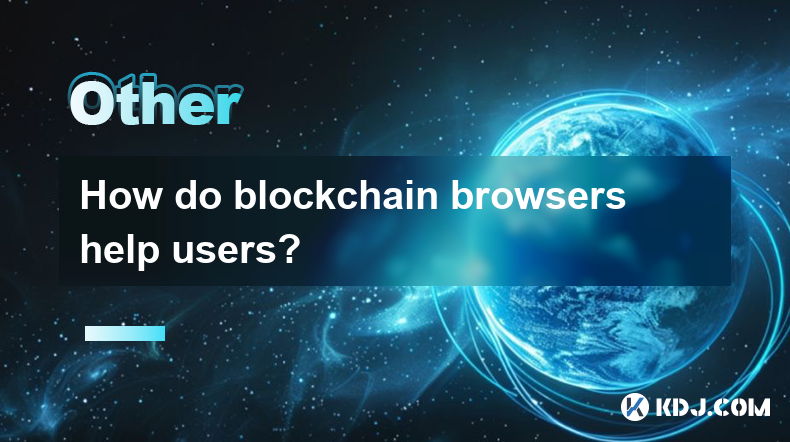
How do blockchain browsers help users?
Mar 29,2025 at 08:28am
Understanding the Role of Blockchain BrowsersBlockchain browsers are specialized tools designed to interact with blockchain networks. Unlike traditional web browsers like Chrome or Firefox, they provide a user-friendly interface for exploring and interacting with the decentralized world of cryptocurrencies and blockchain applications. They offer functi...
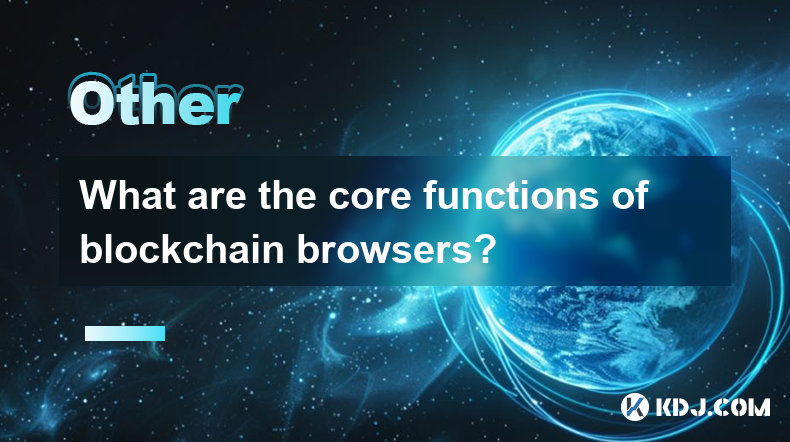
What are the core functions of blockchain browsers?
Mar 29,2025 at 01:50pm
Exploring the Functionality of Blockchain BrowsersBlockchain browsers are specialized tools designed to interact with and explore various blockchain networks. Unlike traditional web browsers, they offer functionalities specifically tailored to the decentralized and transparent nature of blockchain technology. They provide users with a user-friendly int...
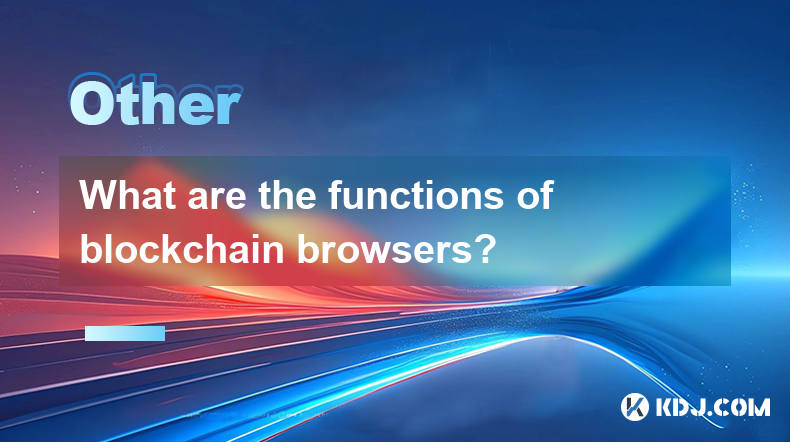
What are the functions of blockchain browsers?
Mar 29,2025 at 07:14am
Exploring the Functionality of Blockchain BrowsersBlockchain browsers are specialized tools designed to interact with and explore various aspects of blockchain networks. Unlike traditional web browsers, they provide functionalities specifically tailored for navigating and understanding the decentralized nature of blockchain technology. They are crucial...
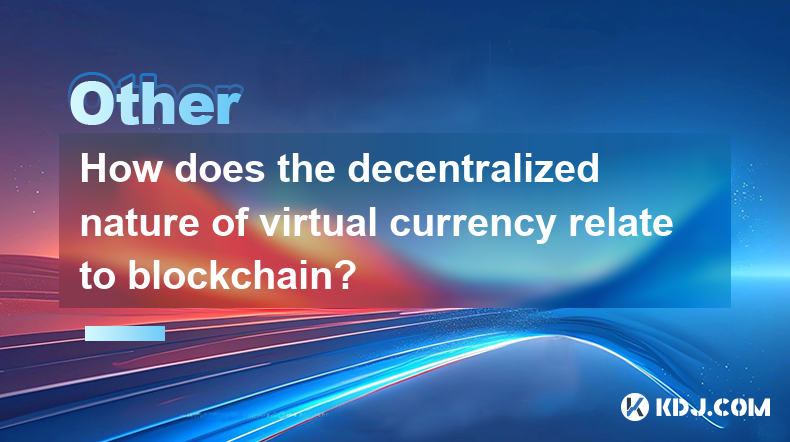
What is the relationship between the decentralized characteristics of virtual currencies and blockchain?
Mar 28,2025 at 06:00pm
In the wave of digital finance, virtual currency attracts everyone's attention with its unique charm, and its decentralized characteristics have become the key to distinguish it from traditional currencies. So what is the close connection between the decentralized characteristics of virtual currencies and blockchain? Don't worry, let's find ...

How does "cross-chain bridge" of blockchain work?
Mar 28,2025 at 03:15pm
Understanding Cross-Chain Bridges in the Cryptocurrency WorldCross-chain bridges are crucial infrastructure in the burgeoning cryptocurrency ecosystem. They facilitate the transfer of digital assets between different blockchain networks, each with its unique architecture and functionalities. This ability to move assets across chains opens up a world of...

How do blockchain browsers query wallet addresses?
Mar 29,2025 at 05:21pm
Understanding Blockchain Explorers and Wallet Address QueriesBlockchain browsers, often called blockchain explorers, are essential tools for interacting with and investigating blockchain networks. They provide a user-friendly interface to view transaction history, block information, and most importantly, the details associated with specific wallet addr...

How do blockchain browsers help users?
Mar 29,2025 at 08:28am
Understanding the Role of Blockchain BrowsersBlockchain browsers are specialized tools designed to interact with blockchain networks. Unlike traditional web browsers like Chrome or Firefox, they provide a user-friendly interface for exploring and interacting with the decentralized world of cryptocurrencies and blockchain applications. They offer functi...

What are the core functions of blockchain browsers?
Mar 29,2025 at 01:50pm
Exploring the Functionality of Blockchain BrowsersBlockchain browsers are specialized tools designed to interact with and explore various blockchain networks. Unlike traditional web browsers, they offer functionalities specifically tailored to the decentralized and transparent nature of blockchain technology. They provide users with a user-friendly int...

What are the functions of blockchain browsers?
Mar 29,2025 at 07:14am
Exploring the Functionality of Blockchain BrowsersBlockchain browsers are specialized tools designed to interact with and explore various aspects of blockchain networks. Unlike traditional web browsers, they provide functionalities specifically tailored for navigating and understanding the decentralized nature of blockchain technology. They are crucial...

What is the relationship between the decentralized characteristics of virtual currencies and blockchain?
Mar 28,2025 at 06:00pm
In the wave of digital finance, virtual currency attracts everyone's attention with its unique charm, and its decentralized characteristics have become the key to distinguish it from traditional currencies. So what is the close connection between the decentralized characteristics of virtual currencies and blockchain? Don't worry, let's find ...

How does "cross-chain bridge" of blockchain work?
Mar 28,2025 at 03:15pm
Understanding Cross-Chain Bridges in the Cryptocurrency WorldCross-chain bridges are crucial infrastructure in the burgeoning cryptocurrency ecosystem. They facilitate the transfer of digital assets between different blockchain networks, each with its unique architecture and functionalities. This ability to move assets across chains opens up a world of...
See all articles






















































































